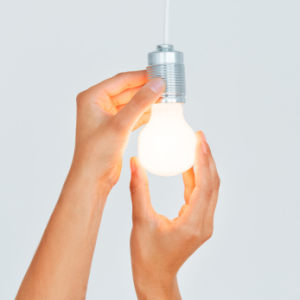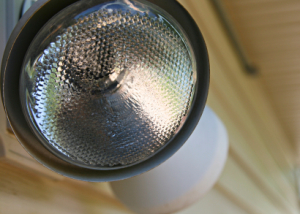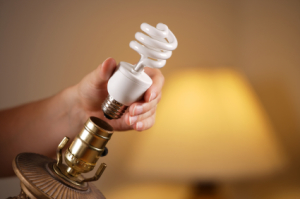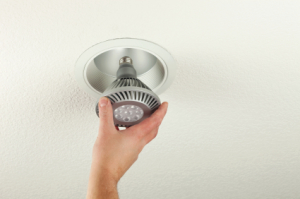Home Lighting
By Elizabeth Hall
A walk down the lighting aisle at your local retailer isn’t what it used to be. The old, relatively homogenous display of incandescent lamps has morphed into rows upon rows of new bulbs, such as halogens, CFLs and LEDs. And while these new bulb, or lamp, options offer consumers even more choices for home lighting, they also can cause confusion. Confronted with all these new lamp offerings, how can you tell which one is right for you? Read more to find the right lamp.
To help you determine which lamp is the right fit, we’re going back to the bulb basics. Here are some quick facts about the four most common types of lamps that you’ll encounter in the hardware aisle.
 Standard Incandescent
Standard Incandescent
- It may be the most commonly recognizable lamp, but this descendant of Thomas Edison’s original light bulb isn’t what it used to be. New government regulation mandated big changes for the incandescent. These energy-efficiency regulations have effectively banned the manufacturing of the most common incandescent lamps, including 100-W and 75-W lamps, to pave the way for lower wattage incandescents, such as 40-W and 60-W bulbs, which consume less energy.
- Lower wattage incandescent lamps can be used anywhere that their energy-inefficient forbearers were used. But because they are still not as energy-efficient as other types of lamps, it’s best to save them for settings where color rendering is key—such as bathroom make-up counters—or where the lights aren’t turned on 24/7. They are also fully dimmable, and work well for dimming fixtures like decorative chandeliers.
Halogen
 Often referred to as a “close cousin” of the standard incandescent lamp, the halogen lamp is actually a type of incandescent that contains a halogen gas mixture. This mix of gasses increases the lamp’s lifetime and produce more light using less energy.
Often referred to as a “close cousin” of the standard incandescent lamp, the halogen lamp is actually a type of incandescent that contains a halogen gas mixture. This mix of gasses increases the lamp’s lifetime and produce more light using less energy.- Some halogens, called halogen IR lamps, have an infrared coating that can double to triple the life of lamp compared to regular halogen lamp.
- While most halogens use less energy that traditional standard incandescent lamps, they produce the same color of light, making them ideal replacements for any applications that use standard incandescents. If dimming, initial cost and color rendering are important, then halogen is an excellent choice. But because it doesn’t save anywhere near as much energy as other common lamp technologies, it may not be the best solution for applications that require lights to be on 24 hours a day, or if you’re looking to save a lot of energy.
CFLs
 While CFLs got a bad rap in their early days, the majority of CFLs of today differ greatly from some of the “green-hued” early predecessors.
While CFLs got a bad rap in their early days, the majority of CFLs of today differ greatly from some of the “green-hued” early predecessors.- CFLs have great energy-saving capabilities, a long life and a low initial cost. In fact, according to the ENERGY STAR’s consumer website, Energy Star certified CFLis can use “75% less energy, produce 75% less heat, and lasts up to 10 times longer” than a standard incandescent. Because of this, they are ideal for almost any ambient or task lighting application. Not all CFLs dim, so be sure to check the package to make sure the bulb is dimmable.
- Some poor quality CFLs can flicker and take a while to start up, so opt for high-quality products. If you want to approximate the color of a standard incandescent, look for CFLs with a correlated color temperature, or CCT, around 2,700-3,000 degree Kelvin.
- Because CFLs contain a small amount of mercury—the same amount in a tuna fish sandwich—they must be properly recycled according to the directions on the packaging. Broken CFL lamps should also be properly cleaned up according to the EPA.
LEDs
 LED is the newest mainstream lamp technology…and it’s often the most misunderstood. And for good reason. LED is drastically unlike other standards lamps, both in terms of technology (it’s a solid-state lighting (SSL) source with a semiconductor chip) and quality (which varies greatly from product to product). So, it’s important to do your homework when buying an LED lamp.
LED is the newest mainstream lamp technology…and it’s often the most misunderstood. And for good reason. LED is drastically unlike other standards lamps, both in terms of technology (it’s a solid-state lighting (SSL) source with a semiconductor chip) and quality (which varies greatly from product to product). So, it’s important to do your homework when buying an LED lamp.- Look at an LED lamp’s lumens, or the amount of light the lamp produces, instead of wattage, the amount of power it uses, when comparing LED lamps to other bulbs. LED bulbs use less wattage than incandescents, but may actually produce more light. You might find that a 10-watt LED produces the same amount of lumens as a 60-watt incandescent, which translates to energy savings.
- LEDs can produce virtually any color light, including the full spectrum of visible white light. Compare the CCT of the LED product you are evaluating to the product you are looking to replace. Typically an LED lamp in the 2,700K-3,000K range will have a similar color to incandescent and warm-white CFL lamps.
- Price is another big difference between LEDs and other mainstream technologies: An LED lamp can cost ten times as much as an incandescent or more! But before sticker shock sets in, consider the cost over the lifetime of the lamp. Some LED lamps last 30,000+ hours, making the lamp an investment that can pay off in the long run. LED lamps also use less energy, and can help you save on energy costs.
- LEDs can be used for task and ambient lighting; decorative lighting styles, such as chandelier bulbs, are also becoming more widely available. Be sure to check packaging for dimming capabilities, since not all LED lamps are dimmable.